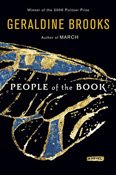Wednesday, April 29, 2009
Hanna Heath arrives in war-torn Sarajevo in 1996 to undertake the "once-in-a-lifetime career maker" project: to analyze and conserve the 14th-century illuminated edition of the Haggadah, the book used to outline the Jewish Passover Seder. Under heavy United Nations and police supervision, Hanna carefully removes the binding and extracts just a few relics of its mysterious past—an insect's wing, a white hair, a swab of what looks like wine, some salt residue and strange grooves. "People of the Book" (Viking Adult, 2008, $25.95) is the story of Hanna's search, findings and speculations—a series of vignettes looking through the past five centuries into the lives of fictional Jews, Muslims and Christians who might have created, carried and salvaged this remarkable volume.
The crux of the Sarajevo Haggadah's significance lies not in its words, but in its beautifully illuminated images: "No one knew why this Haggadah was illustrated with numerous miniature paintings, at a time when most Jews considered figurative art a violation of the commandments," Hanna explains. Appropriately, the origin of these paintings is the last mystery to be solved.
To get there, author Geraldine Brooks begins the story with the Haggadah's most recent savior: the hunky Bosnian Muslim museum director who rescued the book from the museum while under heavy shelling. The story unfolds as Hanna consults experts, super-powered microscopes, and historical records to trace the Haggadah's journey back through space and time; from the mountains of Nazi-occupied Bosnia in the 1940s, to the licentious grit of Vienna in the 1890s, to Inquisition-run Venice of 1609, and Tarragona of 1492, all the way back to Spain's Golden Age of Jewish-Muslim-Christian cooperation in the 1480s.
In each vignette, Brooks introduces new characters that develop and interact against the backdrops of Jewish history's most dramatic and disastrous scenes. Though Brooks includes some cliché characters and improbable scenarios—sex seems to be the solution to many of her characters' problems—by and large she does a masterful job building a diverse cast of honest, complicated and intriguing characters. Her central female characters, in particular, stand out.
Lola—who first appears in the chapter "An Insect's Wing" and then again in "Lola"—is a passive figure in her own life. She begins life as a simple, hard-working young laundress. When the Nazis invade her town, her life is thrown into upheaval, and she is forced to reinvent herself first as a partisan fighter, then as a caretaker of a Muslim family's child and finally as a new immigrant in Israel. At the end of her life, she says: "I know that one day, not so very many days from now, the cold will creep out of the stone and into my body where it lies in this narrow bed. And then I'll never get up again."
In contrast, the character of Ruti Ben Shoushan—from the vignette "Saltwater"—actively, defiantly shapes her destiny. Ruti manages to evade her family's murderers because she is with her illicit lover and catches wind of their plans in time to escape to a cave. There, she finds her brother's Christian wife going into labor all alone. In the face of the Spanish Inquisition, Ruti takes the newborn to the river. "All over Aragon that night, Jews were being forced to the baptismal front, driven to conversion by fear of the exile. Ruti, exultant, defiant, had made a Gentile into a Jew," Brooks writes.
One of Brooks' most impressive storytelling skills is her use of meticulous, matter-of-fact narration to save readers from feeling the emotional turmoil her characters experience. For example, in describing the murder of Ruti's father, Brooks writes, "He lay there, powerless under the blows, as the blood leaking into his brain spread further, and extinguished the light entirely."
Though the material is dense, the plot maintains a steady, brisk pace, and turns out to be a strangely light, enjoyable read.
The understated message of "People of the Book" is the history of cooperation among Europe's Jews, Christians and Muslims. The Sarajevo Haggadah, we learn, never could have been created, and certainly could not have survived 500 years without mutual understanding and appreciation at the most fundamental level.
Yet, even as Hanna untangles this moral from the book's sordid history, she finds herself enmeshed in a new chapter, a secret chapter, replete with its own (frankly unnecessary) tragedies, twists and turns. In the end, we learn that simply acknowledging an intolerant past does not make it go away, and perhaps interfaith cooperation will always operate somewhere below the surface, hidden in clues.

Comments
Use the comment form below to begin a discussion about this content.
Sign in to comment
Or login with:
OpenID